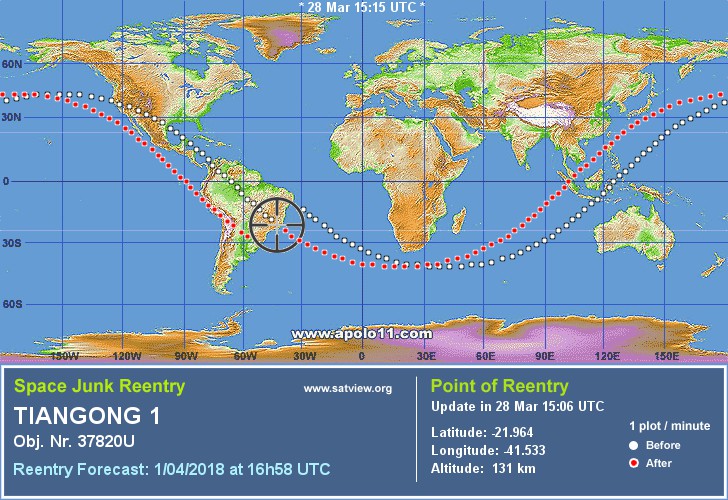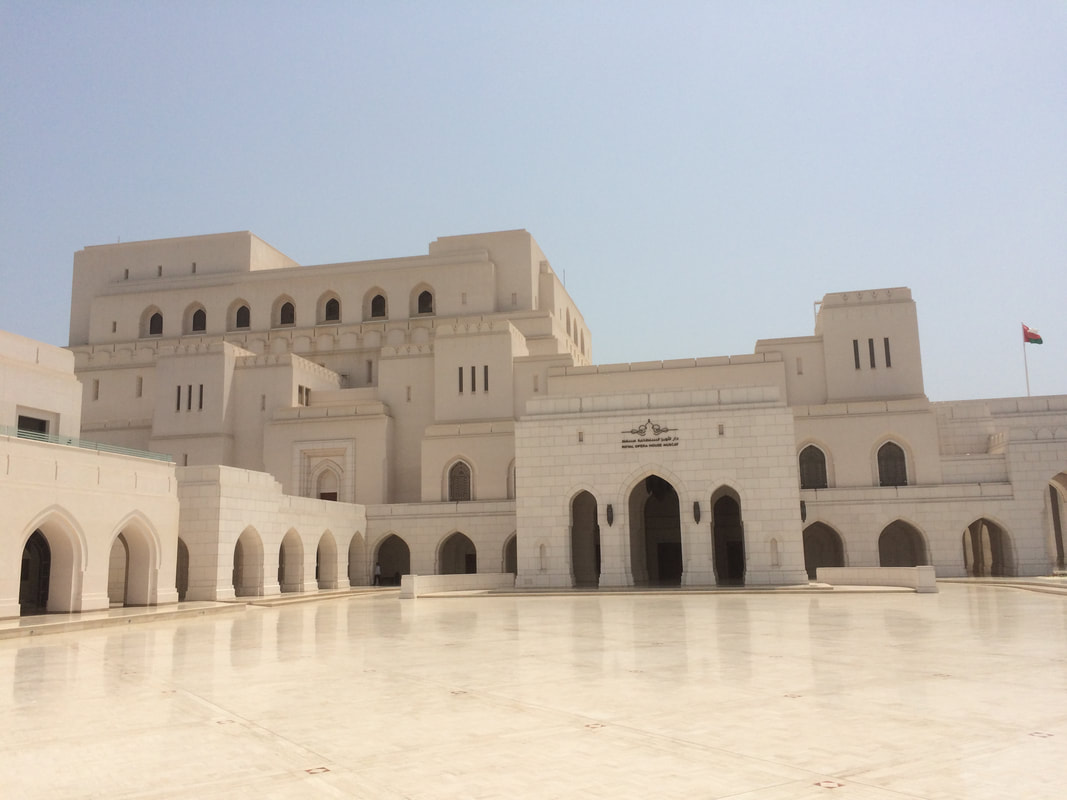|
When Europeans arrived in Rapa Nui (also known as Easter Island) in on Easter Sunday 1722, they were astonished to find the island already had a native community numbering in the thousands. Famous for the giant stone heads (moai) rimming its coastline, Easter Island not only was the most remote populated island in the world, it was likely one of the last places settled by humans (about 900 years ago). Although culturally part of Polynesia, today Easter Island is administered by Chile.
0 Comments
This 50-question online quiz challenges users to identify countries by their shapes and then provides interesting factoids about each one. learn.howstuffworks.com/quiz/97-people-cant-identify-individual-countries-just-a-map-outline-can-you
Two years ago, China reportedly lost control of its prototype space station, Tiangong-1. Tiangong-1, which is about the size of a school bus, is expected to crash to Earth imminently, perhaps this weekend. You can track the position of Tiangong-1 on SatView: www.satview.org/?sat_id=37820U
This article, by a pair of academics specializing in the study of Korea, considers three myths they believe essential to understanding North Korea's negotiation goals and limitations: geographical.co.uk/opinion/item/2660-north-korea-busting-common-myths
Lake Onega is the second largest lake in Europe (after nearby Lake Ladoga) and is today part of Russia's Republic of Karelia although the area (near Finland) has changed hands several times over the centuries. Lake Onega is dotted by more than 1,600 islands, including Kizhi Island. Kizhi is famous for its 18th-century wooden Orthodox churches, several of which are included in the Kizhi pogost UNESCO World Heritage Site. www.atlasobscura.com/places/kizhi-island
Some jurisdictions are in a hurry to move towards fully electric cars. Electric cars, though, still depend on electricity, and how that electricity is generated makes a difference in terms of indirect emissions per mile traveled. This map provides that comparison. static.digg.com/images/6bf5c985bf0f44ebb1fcaf95709d8024_3a0fd41251c34757a1c37dd6b63d9deb_1_post.jpeg
Julian Baggini, the British philosopher whose thought experiments I often use with my "Philosophically Speaking" students, provides an interesting look at the role language plays in how we think about the things themselves and then considers specifically the difference between "consumers" and "citizens":
"When we think of ourselves as consumers ... we obscure another important identity we have: citizens. Whereas consumers are atomised, autonomous decision-makers, citizens are socialised members of society. Citizens do not see their sphere of influence as limited to who they personally trade with. Consumers value independence, citizens recognise our interdependence. Consumers demand and choose, citizens participate and create. Alexander and Ekkeshis [of the New Citizenship Project] point to research that suggests that when we are primed to think of ourselves as consumers we make more selfish choices and become less trusting than when we are primed to think of ourselves as citizens." www.prospectmagazine.co.uk/philosophy/how-we-forgot-the-collective-good-and-started-thinking-of-ourselves-primarily-as-consumers "Pegged as the most ambitious infrastructure megaproject of all time, China's One Belt, One Road initiative (OBOR) will stretch from the very edge of East Asia to East Africa and Central Europe, connecting nearly two thirds of the world's population" via a "continuous network of highways, railways, ocean routes and ports." This map shows the projected routes. www.visualcapitalist.com/wp-content/uploads/2018/03/one-belt-one-road.html
Does your child (age 6-14) have a business to promote? Do you think your kiddo would be inspired by the work of other young entrepreneurs? On Saturday, May 12 in the Cleveland Park neighborhood of Washington, DC, the Acton Children's Business Fair will be highlighting the efforts of child-run businesses. The fair starts accepting applications on April 1. For more information, see dcchildrensbusinessfair.org/
By most accounts, Mexico City is the largest urban area in North America (edging out the New York City metro area). The countries in red on this map have a smaller population than Mexico City. i.redditmedia.com/LzTwUYq_TOhOTnoDC5DU-KB0A_ZzvFfV7CaA0v_Y2uQ.png?w=1024&s=162924fa2399216df02e61157fd22ae0
One of the real-life lessons of world affairs that I try to re-create in my "Mission Possible: Global Issues, Leadership Choices" class is that issues are generally interlocking and interconnected, sometimes in surprising ways. This article explains why the refusal of some Serbs in Kosovo to pay their electricity bills to a state they don't recognize has been causing clocks across Europe to run about six minutes slow! www.atlasobscura.com/articles/why-are-europe-clocks-slow-kosovo
"Post-glacial rebound" is the term used to describe the phenomenon of land that rises in elevation (or rebounds) after millennia of being weighted down by glaciers. Parts of Canada and Greenland, for example, continue to gain in elevation due to post-glacial rebound. This article is about post-glacial rebound in Sweden and Finland, where it is causing problems with river flow, property rights, and shipping. www.cntraveler.com/story/on-the-baltic-coast-of-sweden-and-finland-sea-levels-are-falling
This interesting interactive map considers student debt and allows users to compare average loan balances and delinquency rates, by race or in aggregate, across the U.S.
www.mappingstudentdebt.org/#/map-1-an-introduction Those interested in the philosophy of mind or the mind-body problem might be interested in the new book by MIT professor of neurobiology Alan Jasanoff: The Biological Mind: How the Brain, Body, and Environment Collaborate to Make Us Who We Are. This synopsis captures Jasanoff's thesis:
"To many, the brain is the seat of personal identity and autonomy. But the way we talk about the brain is often rooted more in mystical conceptions of the soul than in scientific fact. This blinds us to the physical realities of mental function. We ignore bodily influences on our psychology, from chemicals in the blood to bacteria in the gut, and overlook the ways that the environment affects our behavior, via factors varying from subconscious sights and sounds to the weather. As a result, we alternately overestimate our capacity for free will or equate brains to inorganic machines like computers. But a brain is neither a soul nor an electrical network: it is a bodily organ, and it cannot be separated from its surroundings. Our selves aren't just inside our heads--they're spread throughout our bodies and beyond." www.amazon.com/Biological-Mind-Brain-Environment-Collaborate/dp/0465052681 More people are using simple DNA kits to check their family ancestries, and many of those who claim Irish ancestry are surprised to see Nordic DNA pop up in their profiles. But many of Ireland's major population centers, including Dublin, were founded by the Vikings. This map shows Ireland c. 950, with Viking holdings in green. www.wesleyjohnston.com/users/ireland/maps/historical/map950.gif
With the arrival of spring comes the arrival of baby animals. This quiz, courtesy of the National Wildlife Federation, allows users to guess the names of various species of baby animal. blog.nwf.org/2018/03/quiz-how-well-do-you-know-baby-animal-names/
This map compares when slavery was formally abolished in the Western Hemisphere. (Because of colonization patterns, not everything lines up neatly with contemporary nation-state borders.) hillfighter.deviantart.com/art/Abolition-of-Slavery-Americas-215869460
Soft power -- one of the metrics students in my "Mission Possible: Global Issues, Leadership Choices" class come to understand firsthand -- is the power to get other people to do what you want because they like, admire, trust, and respect you (as opposed to the coercive force of hard power). This map, based on opinion surveys of European Union residents, hints at shifts in American soft power resources.
www.reddit.com/r/MapPorn/comments/7qrb1w/changing_views_of_the_united_states_in_the_eu/ Most of the U.S. recently switched over to daylight saving time. But there are exceptions, mostly having to do with physical geography. Hawaii and tropical U.S. territories (e.g., Puerto Rico, Guam, the Virgin Islands, American Samoa) do not use daylight saving time. Proximity to the equator makes seasonal variation in daylight less noticeable. Arizona also does not use daylight saving time; the intense daytime heat turns extra daylight into a disadvantage. Interestingly, the Navajo Nation (whose territory is mostly in Arizona but includes adjacent parts of Utah and New Mexico) does use daylight saving time, but the Hopi Reservation, which is an enclave within Navajo lands, does not. roundtripticket.me/media/time-zone-map-of-the-united-states-throughout-north-america.jpg
Google tracks search terms and can aggregate search data by state. These two maps compare where residents searched for "gun shops" vs. "gun control" more frequently. The map on the left is from the last week of February (i.e., after the Florida high school shooting). The map on the right is from the previous year. www.businessinsider.com/gun-control-gun-shop-map-2018-3 Scientists seem to be getting closer to making real philosophy's famous "brain in a vat" thought experiment:
"Thomas DeMarse, a University of Florida professor of biomedical engineering, says his lab-grown rat 'brain' in a dish can fly a simulated F-22 fighter jet via an array of electrodes. DeMarse grew the 25,000-neuron 'brain' in a glass dish. The cells, cortical neurons cultured from a rat brain, sit atop a 60-electrode grid connected to a desktop computer. The neurons then form a two-way connection with the simulator software—much like how our brain gets input from the senses and in return instructs the body how to act. The simulator sends the neurons information about flight conditions—the plane’s attitude, for example—and the neurons return signals to the plane’s controls to alter its path. The process is repeated in a feedback loop, controlling the plane’s flight." As researchers advance development of these "neuronal networks," might there be ethical considerations about the kinds of tasks disembodied "brains" should be put to? The article notes they could be used "as living computers to fly drones or perform operations hazardous to humans in disaster areas or war zones." singularityhub.com/2014/09/04/experimental-rat-brain-fighter-pilot-may-yield-insights-into-how-the-brain-works/ This geo-graphic shows from which countries the U.K. imports black tea. It may surprise many to see African, rather than Asian, countries heavily represented on the list. (Some countries, like the Netherlands, Switzerland, and Poland, do not grow the tea but process it for re-export.) www.statista.com/chart/13062/where-does-the-uks-tea-come-from/
Want to learn about the Middle East from the experts? Now you have the chance (if you're in the DC metro area). The Middle East Institute is running an 8-week class "Middle East 2030: Trends, Challenges & Opportunities" Thursday evenings beginning March 15. For all the information, see www.mei.edu/events/middle-east-2030-trends-challenges-and-opportunities
A recent study analyzing information from the automatic identification system installed on all industrial fishing vessels finds that industrial-scale fishing spans an area four times that covered by terrestrial agriculture and affects more than half the world's ocean area. This map shows the patterns of industrial fishing (yellow=most intensively fished waters). www.sciencenews.org/article/new-mapping-shows-just-how-much-fishing-impacts-world-seas
Transparency International, an NGO that fights corruption by shining a bright light on it, has released its latest Corruption Perceptions Index. Among countries now seen by their residents as having become more corrupt over the last few years: Hungary, Spain, Madagascar, Turkey, El Salvador, Australia, Liberia, and Bahrain. Countries seen as moving towards less corruption include Estonia, Greece, Senegal, Costa Rica, Belarus, Cote d'Ivoire, Latvia, and the Czech Republic. For the full report, see www.transparency.org/news/feature/corruption_perceptions_index_2017.
|
Blog sharing news about geography, philosophy, world affairs, and outside-the-box learning
Archives
December 2023
Categories
All
|


 RSS Feed
RSS Feed